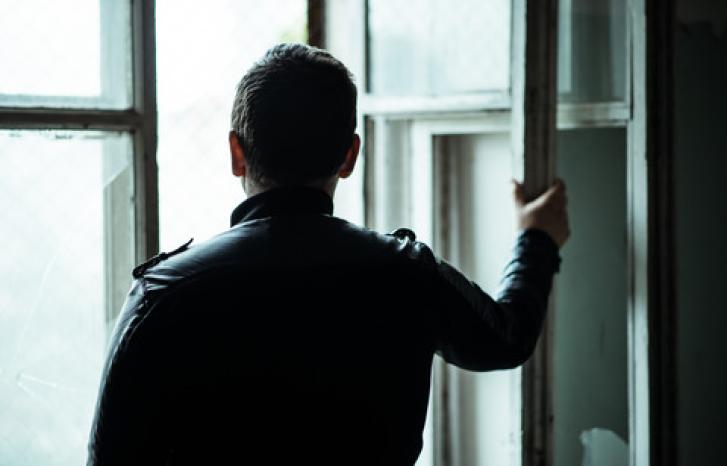“Men who have perpetrated violence against women are often silent about it. It’s also difficult for them to see their own actions in the term violence, and even less so as domestic abuse of women. Their friends can’t manage to see it as that either.”
This is how Lucas Gottzén, a masculinities researcher in the Department of Social and Welfare Studies at Linköping University and co-editor of NORMA: Nordic Journal for Masculinity Studies, presented the findings from his study about men’s violence against women. How does he explain these findings?
Ideal of the gender-equal man
“In Sweden we say that we don’t have a nationalistic tradition. We wave the flag and celebrate our independence day, but we don’t relate to the nationalism found in many other countries. However, we have other things we use as a substitute to create a sense of community. Those are gender equality and the gender-equal man. In Sweden the gender-equal man is hailed as the norm,” notes the masculinities researcher.
Gottzén, who presented his research both for the researchers associated with the Research Council of Norway’s Gender Research Programme and during the conference Masculinities in Motion – Men, Gender Equality and Quality of Life in Oslo recently, believes there is a danger in the paradox that arises between Swedish men’s self-understanding – and their behaviour.
Gender-biased reality
“Swedish politicians have been good at presenting and exporting Sweden as the world’s most gender-equal country. But the reality is that we’re not so gender equal,” says the researcher.
“In reality the statistics hide the fact that Swedish men aren’t as gender equal as we think. Today parents take parental leave, but little is said about the fact the fathers take less leave than mothers. In addition, it is men who subject women and children to a variety of problems, such as paedophilia, violence, rape, etc. These realities run parallel with a self-understanding that at our core we are in favour of gender equality and that we perceive ourselves as very gender equal.”
Gottzén has used qualitative methodology and interviewed men who are in therapy at treatment centres in Sweden for having perpetrated violence against women. Several of the institutions have been influenced by Alternative to Violence, a treatment and knowledge centre started by the Norwegian psychologists Per Isdal and Per Nørbech in 1987.
Ordinary men
The men in the study are getting treatment voluntarily. Some come because they have been reported to the police, who have told them about this form of therapy. Several of them have been encouraged by their partners to seek help or they have found the treatment centre on their own. But who are they?
“Most of them are completely ordinary, Swedish men. A few are ethnic minorities and some have a criminal background or addiction problems, but the majority are white, working class and middle class men with normal jobs such as engineers, teachers, journalists, factory workers or they’re looking for a job,” explains Gottzén.
The number of violent incidents also varies, from once to several times. This can be everything from pushing, hitting and choking to material violence. When the violence is material, the person breaks things, usually something the other person likes, or throws the phone against the wall, or hits the wall with his fist in front of his partner.
See also: Beaten by their wives
Born like that
“Very few of them have a hard time talking about the violence,” says the masculinities researcher.
Here are some examples: “I’ve been physically abusive, but I take responsibility for it.” “I was drunk the first time.” “I was in a psychologically/financially difficult situation, and she was bitchy.”
“More often than not, they say their violent episodes are caused by substances in the brain, ADHD, or problems with drugs, impulse control or aggression. Often they conclude by saying, ‘I take medicine now, and as long as I take it, I won’t become violent,” says Gottzén, and continues:
“Many of them would like to explain away the violence by saying they were born like that. It’s becoming more and more common not to place the blame on a bad childhood but rather find explanations that have to do with different levels of serotonin in the brain or other neuropsychological or physiological factors.”
To explain statements like this, Gottzén uses post-structural perspectives from Gilles Deleuze and Félix Guattari and their ideas about how we relate to categories. How the categories become like a magnet that we are continually trying to free ourselves from. What can explain these tendencies in the material? To answer that, Gottzén turns to Roland Barthes’ theories about myths.
The myth about men
“The Swedish, gender-equal man who hits his partner never thinks of himself as a domestic abuser who continually carries out systematic, controlled and gross violence. An ordinary, Swedish man understands himself as a father, or partner, husband or boyfriend – but some of them in addition hit their partners. From this perspective, he doesn’t view the violence he inflicts as an expression of domestic abuse,” explains the masculinities researcher.
Based on this line of reasoning, the researcher says that the Swedish, gender-equal man is a myth. According to Roland Barthes, myths obscure reality. The myths themselves become the truth. The myth about the Swedish, gender-equal man works like this. It masks the actual situation while excluding everyone who does not fit, everyone who is defined as the Other.
To do good, or not
“Barthes’ concept of the myth reveals several things,” explains Gottzén. “Among other things, it identifies the Other as the oppressor. The myth can recognize certain failures, but it hides everything that resembles systematic problems. For instance, everything that deals with the oppression of women is turned into something that is history, that is behind us. And through our modern self-consciousness, we as men place ourselves outside of the oppression.”
“There’s also a perception that if we hit a domestic abuser or a paedophile, then we come down on the side of good. Then we are protecting women. I find the same attitude in the middle class. Some of my respondents say they would rather be arrested for hitting anyone except a woman.”
“Ugly” incidents must disappear
“This idea about not hitting a woman can be viewed as a gender equality issue, but it can also be seen as a patriarchal argument: Since I as a man am physically stronger, I shouldn’t hit a woman. These two ideologies don’t fit well together at all,” explains Gottzén.
”What do these myths do to Swedish men’s self-perception?”
“To maintain our self-understanding as gender equal, all of the ‘ugly’ incidents need to disappear. Therefore, if we look at this in relation to violence, there is a tendency to explain it in ethnic or cultural terms. For example, we see that violence perpetrated by men from other countries is explained by saying they are immigrant men and thus are naturally violent and patriarchal. In contrast, violence perpetrated by ethnic Swedish men is not understood as cultural, but as a pathology or illness, or it is explained with socio-economic reasons at the individual level,” says the researcher.
Common phenomenon
“Is this a particularly Swedish phenomenon?”
“The prevalence of the gender equality myth is about the same for men throughout Scandinavia. The same holds true for most other Western men, such as the British and Americans,” says Gottzén.
“If we look at different cultures in Sweden, we find very few differences. Regardless of whether the men are criminals, whether they use violence in other situations, such as within a gang culture, or whether they’ve been imprisoned for robbery or violent acts or hitting other men, they still believe it’s wrong to hit their female partner or their children,” the researcher emphasizes.
“All the same, violence against women is much more common in the West, and in Scandinavia, than most people think. Perhaps recognizing this can help men to acknowledge their own violence more quickly,” he concludes.
Translated by Connie Stultz.
See also: Gender equality reduces violence
Lucas Gottzén is an Assistant Professor of Social Work in the Department of Social and Welfare Studies at Linköping University.
He has participated in a number of studies and publications, including as co-editor with Rickard Jonsson of the anthology Andra män. Maskulinitet, normskapande och jämställdhet (“Other Men: Masculinity, Normativity, and Gender Equality”). Gottzén is also co-editor of NORMA: Nordic Journal for Masculinity Studies.



